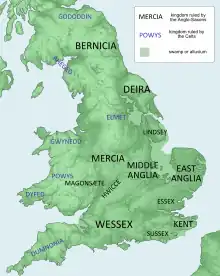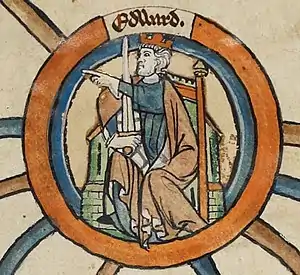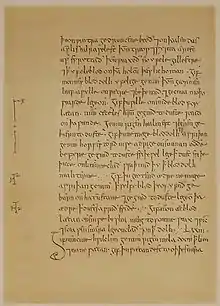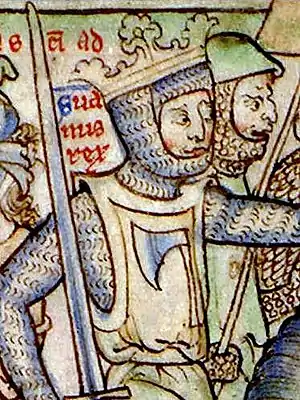Anglo-Saxon England
Anglo-Saxon England or Early Medieval England, existing from the 5th to the 11th centuries from soon after the end of Roman Britain until the Norman Conquest in 1066, consisted of various Anglo-Saxon kingdoms until 927, when it was united as the Kingdom of England by King Æthelstan (r. 927–939). It became part of the short-lived North Sea Empire of Cnut, a personal union between England, Denmark and Norway in the 11th century. The Anglo-Saxons migrated to Britain (Pretanī, Prydain) from mainland northwestern Europe after the Roman Empire withdrawal from the isle at the beginning of the 5th century. Anglo-Saxon history thus begins during the period of sub-Roman Britain following the end of Roman control, and traces the establishment of Anglo-Saxon kingdoms in the 5th and 6th centuries (conventionally identified as seven main kingdoms: Northumbria, Mercia, East Anglia, Essex, Kent, Sussex, and Wessex); their Christianisation during the 7th century; the threat of Viking invasions and Danish settlers; the gradual unification of England under the Wessex hegemony during the 9th and 10th centuries; and ending with the Norman Conquest of England by William the Conqueror in 1066. The Normans persecuted the Anglo-Saxons and overthrew their ruling class to substitute their own leaders for the purposes of overseeing and ruling England. However, Anglo-Saxon identity survived beyond the Norman Conquest, came to be known as Englishry under Norman rule, and through social and cultural integration with Romano-British Celts, Danes and Normans became the modern English people. (Full article...) Selected article
Bald's Leechbook is an Old English medical text that was probably compiled in the 9th century, possibly under the influence of Alfred the Great's educational reforms. It takes its name from a Latin verse colophon at the end of the second book, which begins Bald habet hunc librum Cild quem conscribere iussit, meaning "Bald owns this book which he ordered Cild to compile." (more...) Did you know? Did you know...
SubcategoriesCategory puzzle
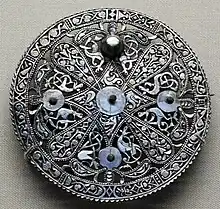 Anglo-Saxon England 5th century in England 6th century in England 7th century in England 8th century in England 9th century in England 10th century in England Anglo-Saxon literature Anglo-Saxon archaeology Anglo-Saxon art Christianity in Anglo-Saxon England Conflict in Anglo-Saxon England 11th century in England Fiction set in Anglo-Saxon England Hen Ogledd Anglo-Saxon kingdoms Anglo-Norse England Old English Anglo-Saxon paganism Anglo-Saxon people Peoples of Anglo-Saxon England Anglo-Saxon studies scholars Anglo-Saxon settlements Anglo-Saxon society Selected image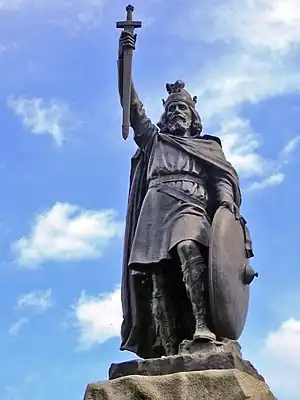 Hoard of Anglo-Saxon rings The statue of Alfred the Great at Winchester by Hamo Thornycroft (1899). Selected biography
Sweyn I Forkbeard (Old Norse: Sveinn Tjúguskegg; c. 960 − 3 February 1014) was king of Denmark and England, as well as parts of Norway. His name appears as Swegen in the Anglo-Saxon Chronicle. He was a Viking leader and the father of Cnut the Great. On his father Harald Bluetooth's death in late 986 or early 987, he became King of Denmark; in 1000, with allegiance of the Trondejarl, Eric of Lade, he was ruler over most of Norway. After a long effort at conquest, and shortly before his death, in 1013 he became the first of the Danish Kings of England. (more...) Things you can do
Featured articles and lists
Related portalsWikiProjects
Associated WikimediaThe following Wikimedia Foundation sister projects provide more on this subject:
| |||||||||||||||||||
